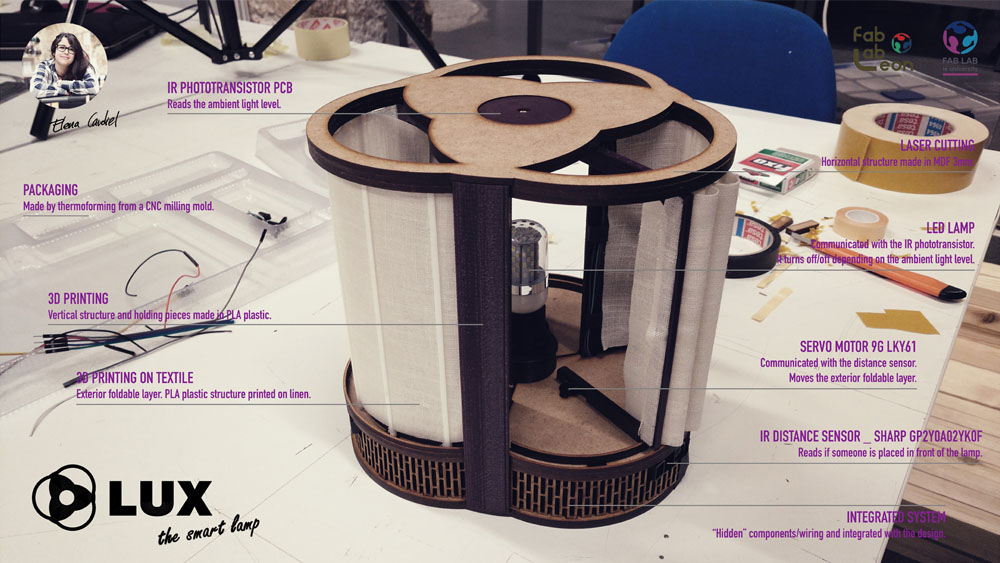Invention, intellectual property, and income
Week 20
Like every week I started the week planning the assignment.
For this week, I decided to spend most of my time to develop the final project. That is my priority for now. I will make this assignment at the end of the week (I don't want to have anything pending for after the final and, although I have never thought about this topic and I am really interested in knowing how it works, I think this will not take long).
Invention
Lux (the final project's name) is a smart lamp, a product. I have been always interested in product design and furniture design (if I can, I prefer to make instead of buying) so the Fab Academy has been the excuse to develop a project that integrates design and electronics, something that I had never done before.
Although the design is the developing of my own ideas, none of the processes or knowledge involved in this project can be considered an invention of mine. I have built upon existing knowledge and information, therefore, I do not pretend to own any exclusive rights on that.
However, it is the harmonious combination of all this knowledge what makes Lux an original product. Lux is not a copy or adaptation of a previous design, so I consider then, although the processes for its fabrication and programming are not originally mine, the final product is, so I would like to be mentioned, attributed and cited as its author.
Intellectual property
Although all the works developed during the Fab Academy are protected under The MIT License, and having in mind that I am mainly using opensource software to develop my project, it makes sense to me to also have my own Creative Commons license.
Creative Commons (CC) is an American non-profit organization focus on expanding the number of creative works available for others to build upon legally and to share. The organization has a list of several copyright-licenses, free of charge to the public, which allow creators to communicate their work specifying which the rights they deserve, and which rights they waive for the benefit of sharing with others. These licenses come with associated visual symbols that make easy to understand the explanation of rights. Creative Commons licenses do not replace copyright but are based on it.
For my project I will use:

This work is licensed under a Creative Commons Attribution-NonCommercial-ShareAlike 4.0 International License.
This means that:
You are free to: share (copy and redistribute the material in any medium or format) and adapt (remix, transform, and build upon the material).
Under the following terms:
Attribution: you must give appropriate credit, provide a link to the license, and indicate if changes were made. You may do so in any reasonable manner, but not in any way that suggests the licensor endorses you or your use.
NonCommercial: you may not use the material for commercial purposes.
ShareAlike: if you remix, transform, or build upon the material, you must distribute your contributions under the same license as the original.
Income
Initially, when I was devising Lux I didn't think about it as a product to sell and earn money with that but now I think it would be an opportunity to me to explore the business path. I think it would be three ways to get benefit from this:
> Files: for those who have access to a Fab Lab or Maker Space, they would pay for the completed set of files.
> Kit: for those that don't have access to a Fab Lab or Maker Space, so they don't have the resources to fabricate their own Lux, but they would like to build their own lamp, they would pay for a kit with all the pieces and components. (In fact that is how Lux was thought from the beginning, as a kit).
> Product: for those how just want to have a Lux but they are only interested in the final product itself, they would pay for the final piece of furniture.
Looking further, to get the funds to develop all of this, I think my first idea would be to go to Kickstarter and start a new project.
On the other hand, I am really interesting now in Opendesk. It would be awesome to have the opportunity to collaborate with them.
And if I finally decided to not get an economic benefit from this, I will probably upload my work on Instructables.
But, do you know what would be super cool? That our students of IE University, and others all around the world, replicate and improve Lux, in order to learn about digital fabrication and electronics. That would be really really nice. That would make me extremely happy, you know, to have the opportunity to see how Lux grows thanks to the ideas and imagination of others and that the project serves for making this "Fab Lab / Maker family" bigger and bigger.
Drafts of the summary slide and video clip
This week we were also asked to make a sketch of the final video and slide. I took a look of the last year slides and I thought it would be a good idea to have just one full photo where I can explain all the components of the project, instead of to have a lot of tiny images that, in my opinion, are difficult to understand.

For the video, I just made a quickie composition, just to upload it to the repository and check that the format is the correct one and that I have linked it properly, as well as the slide.